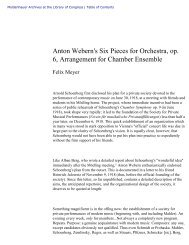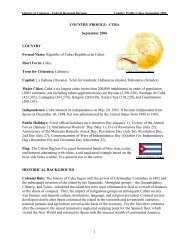1 - American Memory
1 - American Memory
1 - American Memory
You also want an ePaper? Increase the reach of your titles
YUMPU automatically turns print PDFs into web optimized ePapers that Google loves.
175<br />
THE 1S72 WEST COAST UABrTIME STRIKE<br />
The Masters, Mates and Pilots Union struclt the Pacific Maritime Association<br />
on October 25,1&72, just before the critical holiday shopping season, leaving many<br />
Hawaii stores without their Christmas goods. A strike was not expected, and<br />
when it came, news reports anticipated only a brief stoppage. But the strike<br />
lasted 41 days—until December 4. A union of approximately 300 members was<br />
able to tie up the whole Pacific Coast merchant fleet of 67 ships for 41 days, cut-<br />
ting o£f supplies for more than 800,000 people in Hawaii. The dispute was finally<br />
settled on terms that were basically the same as those offered before the strike.<br />
It is impossible to gauge the total impact of these transportation interruptions<br />
on the Hawaiian economy. There is no way to measure the number of business-<br />
men who decided not to invest in Hawaii or the number of vacationers who de-<br />
cided not to visit Hawaii because of a strike—or even the threat of one. But the<br />
impact is painfully clear in the Increased costs of doing business, the unemploy-<br />
ment, and the rises in the cost of living resulting from these strikes.<br />
The first and the hardest hit is the local business community. Retailers and<br />
wholesalers can't get their merchandi.se; construction firms can't get their ma-<br />
terials; farmers can't get their chemicals and feeds; and manufacturers can<br />
neither get their supplies nor reach their usual markets.<br />
Inured to the problem, many Hawaii firms resort to stockpiling supplies when<br />
a strike is threatened. But the costs of extra warehousing and handling and of<br />
borrowing or tieing up capital to build inventory are tremendous. Some businesses<br />
devise emergency alternative means of reaching su{4>liers or markets—using air<br />
shipments during an ocean tie-up, routing goods through East Coast ports when<br />
West Coast ports are struck, etc. But this, too, is expensive. The squeeze on busi-<br />
nesses was especially severe during the 1971 West Coast dock strike, when<br />
I'ha.se I of the wage-price freeze prevented them from passing on most of these<br />
added costs. (Whether the costs are passed on are absorbed, of course, someone<br />
in Hawaii ends up paying.)<br />
As the strike wears on, the impact on the business community is compounded.<br />
Local business services and lenders suffer as accounts fall behind in their pay-<br />
ments. Advertising volume Is reduced because merchants have nothing left to<br />
.sell. Architects find that construction plans are put off, while employment agen-<br />
cies find that no one is hiring.<br />
During the local dock strike in 1949, retail sales in Hawaii fell 12.5 percent<br />
below the same period in the previous year, while nationally they showed no<br />
appreciable change. With many small businessmen giving up entirely, out-<br />
migration accelerated and bank deposits declined. Farmers suffered severe short-<br />
ages of fertilizer and feed, and some were forced to kill off part of their livestock.<br />
Construction volume dropped precipitously, and even the number of visitors to<br />
Hawaii was reduced.<br />
During the 1971 West Coast dock strike, a pronounced slowing In the State's<br />
general fund tax collections reflected the overall damage endured by Hawaii's<br />
businesses. Revenues had increased 9 percent in the fiscal year ending June 80,<br />
1971, the day before the strike began. But in the following five months, when<br />
Hawaii was In the midst of or recovering from the strike, the rate of increase<br />
in revenues slid to 2.8 percent. While it Is true that 1971 was a recession year<br />
for Hawaii, tax revenues were up In the six months directly preceding the strike,<br />
with June ahead of the previous ,Tune by 9.9 percent.<br />
Responding to a survey on the Impact of the 1971 strike, local retailers reported<br />
.sales declines ranging from 3 to 17 percent. Because of extra Inventory and<br />
transportation costs, however, the drop in their profits was much more marked.<br />
Profits before taxes were down 50 percent from normal for a foreign car dealer,<br />
down 53 percent for an appliance dealer, down 25 percent for a housewares<br />
dealer, and down 19 percent for one drug store. A domestic car dealer reported<br />
profits down 200 percent (a loss, In other words), while for a paper products<br />
dealer profits were down 138 percent. Most busines.'ses sun-lved the strain, but<br />
some could not. One medium-sized furniture store struggled through the 134<br />
days of the 1971 and early 1972 West Coast dock strikes, but it was caught<br />
by surprise by the deck officers' strike in the fall of 1972. Christmas furniture<br />
orders arrived too late for the holiday buying season, and the store went out of<br />
business.<br />
The 1971-72 strike also had a severe effect on the State's construction Industry.<br />
Construction in progress suffered lengthy delays, Increasing costs considerably.



![Albert Einstein Papers [finding aid]. Library of Congress. [PDF ...](https://img.yumpu.com/21604228/1/190x245/albert-einstein-papers-finding-aid-library-of-congress-pdf-.jpg?quality=85)





![American Colony in Jerusalem Collection [finding aid]. Library of ...](https://img.yumpu.com/17941275/1/190x245/american-colony-in-jerusalem-collection-finding-aid-library-of-.jpg?quality=85)



![Piccard Family Papers [finding aid]. - American Memory - Library of ...](https://img.yumpu.com/17941234/1/190x245/piccard-family-papers-finding-aid-american-memory-library-of-.jpg?quality=85)


